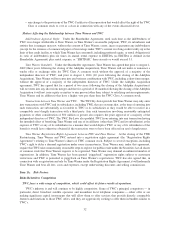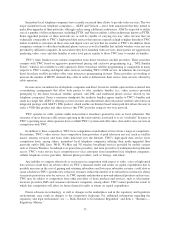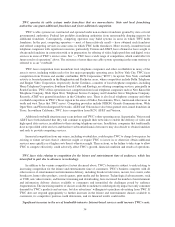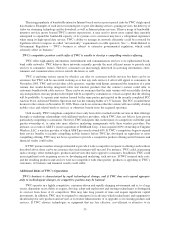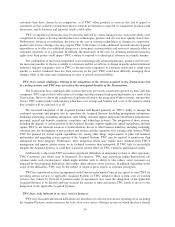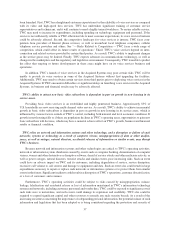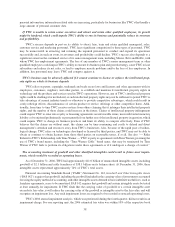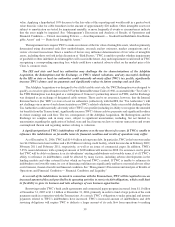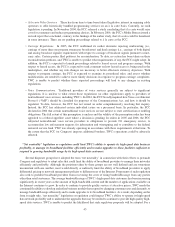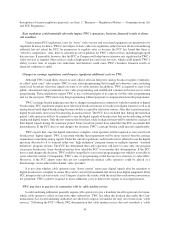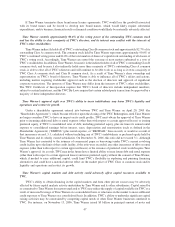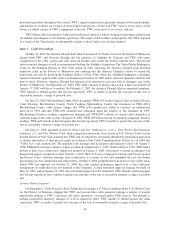Time Warner Cable 2006 Annual Report Download - page 44
Download and view the complete annual report
Please find page 44 of the 2006 Time Warner Cable annual report below. You can navigate through the pages in the report by either clicking on the pages listed below, or by using the keyword search tool below to find specific information within the annual report.value. Applying a hypothetical 10% decrease to the fair value of this reporting unit would result in a greater book
value than fair value for cable franchises in the amount of approximately $20 million. Other intangible assets not
subject to amortization are tested for impairment annually, or more frequently if events or circumstances indicate
that the asset might be impaired. See “Management’s Discussion and Analysis of Results of Operations and
Financial Condition — Critical Accounting Policies — Asset Impairments — Goodwill and Indefinite-lived Intan-
gible Assets” and “— Finite-lived Intangible Assets.”
The impairment tests require TWC to make an estimate of the fair value of intangible assets, which is primarily
determined using discounted cash flow methodologies, research analyst estimates, market comparisons and a
review of recent transactions. Since a number of factors may influence determinations of fair value of intangible
assets, including those set forth in this discussion of “Risk Factors,” TWC is unable to predict whether impairments
of goodwill or other indefinite-lived intangibles will occur in the future. Any such impairment would result in TWC
recognizing a corresponding operating loss, which could have a material adverse effect on the market price of its
Class A common stock.
The IRS and state and local tax authorities may challenge the tax characterizations of the Adelphia
Acquisition, the Redemptions and the Exchange, or TWC’s related valuations, and any successful challenge
by the IRS or state or local tax authorities could materially adversely affect TWC’s tax profile, significantly
increase TWC’s future cash tax payments and significantly reduce its future earnings and cash flow.
The Adelphia Acquisition was designed to be a fully taxable asset sale, the TWC Redemption was designed to
qualify as a tax-free split-off under section 355 of the Internal Revenue Code of 1986, as amended (the “Tax Code”),
the TWE Redemption was designed as a redemption of Comcast’s partnership interest in TWE, and the Exchange
was designed as an exchange of designated cable systems. There can be no assurance, however, that the Internal
Revenue Service (the “IRS”) or state or local tax authorities (collectively with the IRS, the “Tax Authorities”) will
not challenge one or more of such characterizations or TWC’s related valuations. Such a successful challenge by the
Tax Authorities could materially adversely affect TWC’s tax profile (including its ability to recognize the intended
tax benefits from the Transactions), significantly increase TWC’s future cash tax payments and significantly reduce
its future earnings and cash flow. The tax consequences of the Adelphia Acquisition, the Redemptions and the
Exchange are complex and, in many cases, subject to significant uncertainties, including, but not limited to,
uncertainties regarding the application of federal, state and local income tax laws to various transactions and events
contemplated therein and regarding matters relating to valuation.
A significant portion of TWC’s indebtedness will mature over the next three to five years. If TWC is unable to
refinance this indebtedness on favorable terms its financial condition and results of operations may suffer.
As of December 31, 2006, TWC had $14.4 billion in long-term debt. In particular, TWC is the borrower under
two $4.0 billion term loan facilities and a $6.0 billion revolving credit facility, which become due in February 2009,
February 2011 and February 2011, respectively, as well as an issuer of commercial paper. In addition, TWE’s
7.25% senior debentures with a principal amount of $600 million will mature in 2008. No assurance can be given
that TWC will be able to refinance its or its subsidiaries’ existing indebtedness on favorable terms, if at all. TWC’s
ability to refinance its indebtedness could be affected by many factors, including adverse developments in the
lending markets and other external factors which are beyond TWC’s control. If TWC is unable to refinance its
indebtedness on favorable terms, its cost of financing could increase significantly and have a material adverse effect
on its business, financial results and financial condition. See “Management’s Discussion and Analysis of Results of
Operations and Financial Condition — Financial Condition and Liquidity.”
As a result of the indebtedness incurred in connection with the Transactions, TWC will be required to use an
increased amount of the cash provided by its operating activities to service its debt obligations, which could limit
its flexibility to grow its business and take advantage of new business opportunities.
Borrowings under TWC’s bank credit agreements and commercial paper program increased from $1.1 billion
at December 31, 2005 to $11.1 billion at December 31, 2006, primarily in order to fund a large portion of the cash
payments made in connection with the Transactions. As a result, TWC’s obligations to make principal and interest
payments related to TWC’s indebtedness have increased. TWC’s increased amount of indebtedness and debt
servicing obligations will require TWC to dedicate a larger amount of its cash flow from operations to making
39





